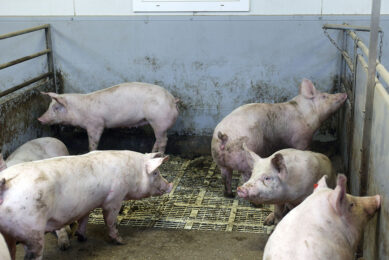Acidic slurry more climate-friendly

An increasing number of farmers add sulphuric acid to livestock slurry in order to reduce ammonia emissions. This is good for the environment. Now scientists from the Faculty of Agricultural Sciences at Aarhus University have shown that adding acid has an additional beneficial effect.
It reduces emissions from slurry of the powerful greenhouse gas methane – and the effect persists even after several months of storage. However, the results also indicate that acidification can increase the risk of problems with odour.
Trials carried out
”We expected acidification to not only reduce ammonia emission, but also to inhibit methane-producing bacteria. We have carried out some trials which showed that this was indeed the case”, explains Søren O. Petersen from the Department of Agroecology and Environment at the Faculty of Agricultural Sciences.
As a greenhouse gas methane is more than 20 times as powerful as carbon dioxide. Emissions of methane from animal manure account for almost 10 percent of total greenhouse gas emissions from Danish agriculture.
”That is why treatment techniques that reduce methane emissions during storage are interesting”, says Søren O. Petersen.
Methane emissions measured
The scientists measured methane emissions from cattle slurry with and without acidification during three months of storage. The slurry was either untreated or treated with various sulphur sources. While the untreated slurry emitted methane during the whole 100-day period, the emission from slurry treated with sulphuric acid was reduced by 90 percent.
There is, however, a downside to the good news: the risk of increasing smell.
The turnover of sulphur in the slurry can lead to production of several extremely pungent organic sulphur compounds. Bacteria such as methane-producing bacteria would normally break them down quickly. However, if acidification or other mechanisms inhibit these bacteria, then the odorous compounds can accumulate in the slurry, escape to the atmosphere and be unpleasant for the environment.
Collaboration
Scientists from several departments at the Faculty of Agricultural Sciences are collaborating on charting the processes in the acidified slurry. Understanding the regulation of degradation pathways can perhaps help pave the way for new technical solutions.
”If we are to take advantage of the beneficial effect of acidification on ammonia and methane without risking increased problems with smell, then we need to understand the microbiological metabolic pathways”, says Søren O. Petersen.
The results of the current study will be published in 2009.
Related Website
• Faculty of Agricultural Sciences at Aarhus University
Click here for the free Pig Progress newsletter
Trials carried out
”We expected acidification to not only reduce ammonia emission, but also to inhibit methane-producing bacteria. We have carried out some trials which showed that this was indeed the case”, explains Søren O. Petersen from the Department of Agroecology and Environment at the Faculty of Agricultural Sciences.
As a greenhouse gas methane is more than 20 times as powerful as carbon dioxide. Emissions of methane from animal manure account for almost 10 percent of total greenhouse gas emissions from Danish agriculture.
”That is why treatment techniques that reduce methane emissions during storage are interesting”, says Søren O. Petersen.
Methane emissions measured
The scientists measured methane emissions from cattle slurry with and without acidification during three months of storage. The slurry was either untreated or treated with various sulphur sources. While the untreated slurry emitted methane during the whole 100-day period, the emission from slurry treated with sulphuric acid was reduced by 90 percent.
There is, however, a downside to the good news: the risk of increasing smell.
The turnover of sulphur in the slurry can lead to production of several extremely pungent organic sulphur compounds. Bacteria such as methane-producing bacteria would normally break them down quickly. However, if acidification or other mechanisms inhibit these bacteria, then the odorous compounds can accumulate in the slurry, escape to the atmosphere and be unpleasant for the environment.
Collaboration
Scientists from several departments at the Faculty of Agricultural Sciences are collaborating on charting the processes in the acidified slurry. Understanding the regulation of degradation pathways can perhaps help pave the way for new technical solutions.
”If we are to take advantage of the beneficial effect of acidification on ammonia and methane without risking increased problems with smell, then we need to understand the microbiological metabolic pathways”, says Søren O. Petersen.
The results of the current study will be published in 2009.
Related Website
• Faculty of Agricultural Sciences at Aarhus University
Click here for the free Pig Progress newsletter











